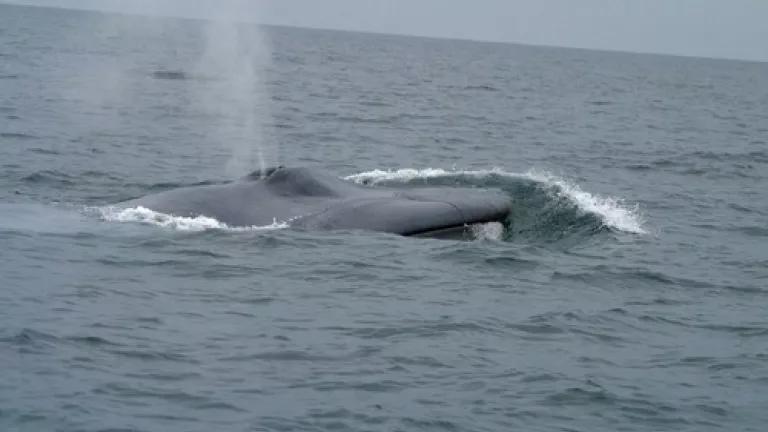
Blue whales might be the largest animals on the planet and have a heart the size of a small car, but they are not impervious to sonar. Quite the opposite, a Southern California Behavioral Response Study confirmed.
A team of researchers placed suction cup tags on seventeen blue whales off the coast of Southern California, simulated Navy mid-frequency active (MFA) sonar signals, and measured the whales’ behavioral response. The blue whales subjected to the sound ceased foraging, altered their dive pattern, increased their swim speed, and fled the noise. One blue whale’s panicked flight was likened to the response these whales have to a killer whale attack. Another whale exposed to the simulated sonar terminated foraging for over an hour, missing out on an estimated tonne of krill, or roughly the total amount of food a blue whale needs to meet its daily metabolic needs.
Eighty years ago, blue whales were hunted to the brink of extinction. Today, there are only 8,000 to 10,000 blue whales remaining, and almost 700 of them come to the West Coast each summer to feed—comprising the largest single concentration of blue whales in the world.
Tragically for these gentle giants, Southern California is also the epicenter of Navy activity on the West Coast. The Navy recently announced a 5-year plan (January 2014 to 2019) to train and test off the Southern California Coast that includes more than 10,000 hours of high-intensity sonar use each year and over 51 thousand underwater detonations each year, in addition to torpedo tests, ship sinking events, bombing exercises, unmanned underwater vehicles, and mine exercises.
The scientists warn that continued use of Navy sonar near blue whale feeding areas imperils not just individual feeding performance but the population of these endangered whales as a whole. “[O]ur results suggest that frequent exposure to mid-frequency anthropogenic sounds may pose significant risks to the recovery rates of endangered blue whale populations, which unlike other baleen whale populations (i.e. humpback, grey and fin whales), have not shown signs of recovery off the western coast of North America in the last 20 years,” the researchers write.
A related paper found even stronger responses to MFA sonar of Cuvier’s beaked whales. When exposed to simulated sonar, the beaked whales initiated an avoidance response that included energetic fluking (i.e. lifting their tails), swimming away from the source, and ceasing eating for up to 7.5 hours. The researchers characterize the whales’ responses as long-lasting, intense, and consistent, and they note that these responses occurred at sound levels far below what the government currently considers harmful.

Cuvier’s beaked whales (family Ziphiidae) are deep diving whales that use echolocation clicks to find food. They also frequent California waters; however, their population numbers were recently found to be in rapid decline within the California Current Ecosystem. Beaked whales are the whales that are most frequently killed in mass stranding events related to military sonar exercises. For more information on beaked whales and stranding, you can read my blog and Michael Jasny’s blog.
The Navy itself estimates that its planned activities for 2014 to 2019 will cause 8.8 million instances of harm to Southern California marine mammals. These two studies, published last week, confirm that the toll on vulnerable and endangered species will be even higher than predicted.
Currently, in conducting its exercise, the Navy makes almost no effort to avoid—or even identify—areas of biologically important habitat to marine species. The resulting harm to marine mammals is intolerable. The Navy can no longer deny that it is having population-level impacts on baleen and beaked whales: it not only funded the research, its own scientists worked on the studies. The Navy must begin to train in such a way that reduces harm by avoiding vital whale habitat and restricting sonar use in areas where whales migrate, feed, and calve.
Blue whales and beaked whales are forced to listen to the Navy train and test in their habitat, with serious consequences. It’s time for the Navy to listen to the whales.
Photo Credit: NOAA and The Marine Mammal Institute at Oregon State University, respectively

